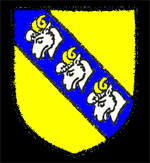The Manor of Shillington

The arms of Ramsey Abbey
The Domesday Book of 1086 tells us that Shillington comprised 10 hides and was held by Ramsey Abbey. Volume II of The Victoria County History for Bedfordshire was published in 1908 and hypothesizes that this land belonged to a man named Ailwin, a alderman of King Edgar (942-975) and that it was purchased between 1016 and 1034 by Æthelric, Bishop of Dorchester and given to the abbey by him.
The manor grew during the Middle Ages thanks to gifts to the abbey. In 1265 Ralph de Tyville granted half a carucate, Peter de Buel making a similar grant about the same time. The abbey often leased the manor and its manor house (as the manor house of a manor owned by a religious foundation the house was, technically, a grange) out. The manor house is thought, from the evidence of moats and ditches, to be somewhere near today's Shillington Bury. When Ramsey Abbey was dissolved in 1539 the manor was worth £88 2 shillings and 10 pence.
The manor became part of the Honour of Ampthill in 1540. It was conferred on Princess Elizabeth (later Elizabeth I) in 1551 and later formed part of the dowry of Anne of Denmark, wife of James I (1603-1625). The manor house was leased out by the Crown, George Rotherham holding it in 1594 on a 21 year lease.
In 1625 the manor was leased to Sir Henry Hobart on a 99 year lease, who transferred it to Anthony Chester after three years, his son Henry succeeding him. In 1711 Roger Gillingham sold the lease to John Borrett for £1,340. In 1764 left the manor to Henry Yelverton, 3rd Earl of Sussex [not Essex as stated in Victoria County History] in his will for the life of the earl with a remainder to Margaret Arnold and Frances Skegness, daughters of Grey Longueville. On the earl's death the manor descended to Margaret's great-grandson Grey Arnold and Frances' granddaughter Bridget Frances Anne.
The Hanscombe family purchased the manor in the middle of the 19th century. A number of law of Property Acts in the 1920s effectively abolished manors in almost all but name.